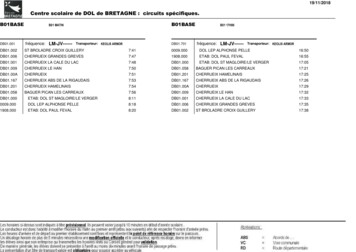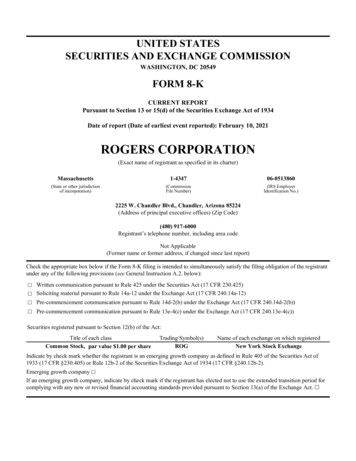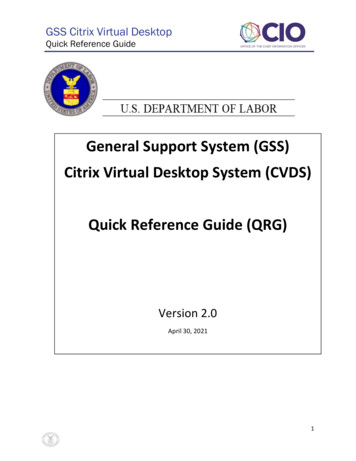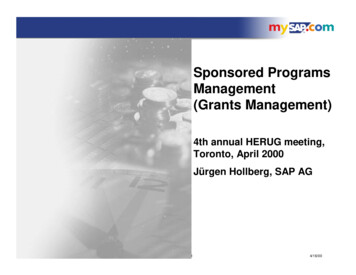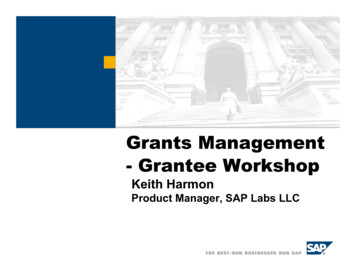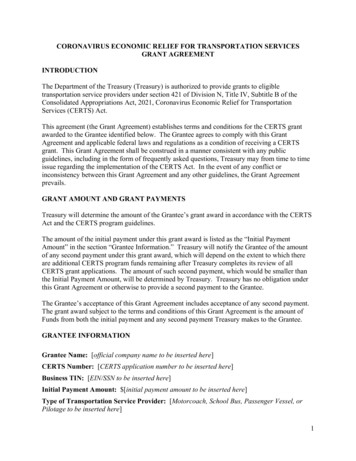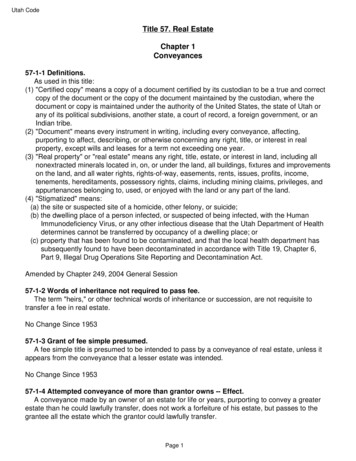
Transcription
Effectively Managing Competitive GrantsU.S. DEPARTMENT OF LABOREMPLOYMENT AND TRAINING ADMINISTRATIONGrantee HandbookISSUE DATE: JUNE 2020Disclaimer – This handbook is a general resource designed to orient grantees to the grant process inETA. Specific details about particular grants may differ.DOL/ETA Grantee Handbook
TABLE OF CONTENTSWELCOME! . 3SECTION 1 – ETA’S TEAM APPROACH TO GRANT MANAGEMENT – ORGANIZATIONALROLES AND RESPONSIBILITIES .5SECTION 2 – AN OVERVIEW OF AWARD DOCUMENTS, GRANTEE OBLIGATIONS, ANDREGULATORY REQUIREMENTS .8SECTION 3 – HOW TO MANAGE YOUR PERIOD OF PERFORMANCE .20SECTION 4 – MODIFYING GRANTS .32SECTION 5 – EVALUATION: WHAT YOU NEED TO KNOW AS A GRANTEE .43SECTION 6 – AUDIT PHASE .44SECTION 7 – CLOSEOUT PHASE.47APPENDIX A – GENERAL PARAMETERS GOVERNING USE OF ETA GRANT FUNDS .50APPENDIX B – ETA NATIONAL TOLL-FREE HELPLINE .55APPENDIX C – ELECTRONIC TOOLS GUIDE .56APPENDIX D – RESOURCES AND CONTACTS .59APPENDIX E – GLOSSARY OF ACRONYMS .61APPENDIX F – AGENCY TELEPHONE LIST 63DOL/ETA Grantee Handbook
WELCOME!Congratulations on receiving one of numerous Department of Labor’s (DOL) Employment andTraining Administration’s (ETA) grant awards which collectively play a vital role in the lives of millionsof job seekers throughout the United States. These awards provide job training, career pathways,credential attainment, and employment opportunities to millions of customers who are authorized towork in the United States of America. By law, ETA’s funded workforce development services andactivities are designated for job seekers expressly authorized to work in the U.S., per the ImmigrationReform and Control Act. We are committed to our customers and your success and recognize thesometimes overwhelming responsibility of administering grants. ETA’s goal in assembling thisGrantee Handbook is to ensure that you have information and resources in hand to successfullynavigate this vitally important task.This Grantee Handbook is presented in seven sections. Each section contains pertinent informationthat you and your staff need to know regarding the goals and expectations for managing an ETAcompetitively-awarded grant.1. ETA’s TeamApproach to GrantManagement –OrganizationalRoles andResponsibilities2. An Overview ofAward Documents,GranteeObligations, andRegulatoryRequirements3. How to ManageYour Period ofPerformance Describes specific leadership and coordination roles expected of ETAgrantees and provides guidance to help you succeed in meeting promisedmilestones and deliverables. Categories of guidance covered in this sectioninclude: Explanation of responsibilities and obligations regarding administrativeprocedure, project staffing, workforce development and training,employer and partner engagement, financial reporting, and participationin monitoring activities; Making the most strategic use of the project planning phase; and Finding relevant technical assistance resources from ETA.4. Modifying Grants Explains the grant modification process and the types of modifications thatare possible.Includes a modification checklist and a step-by-step description of themodification review process and timeframe. 3 DOL/ETA Grantee HandbookDescribes how ETA’s Regional and National Offices work together tomanage competitively-awarded grants.The roles and responsibilities of ETA staff during the grant life cycle.Walks through the content of each document included in your Grant AwardPackage.Provides a framework for helping you and your staff manage your grant sothat it closely aligns with the goals, responsibilities, and commitmentsoutlined in your approved Grant Agreement.
5. Evaluation: What DoI Need to Know AsA Grantee? 6. Audit Phase 7. Closeout Phase Provides an overview of ETA’s grant evaluation process, expectationsregarding your potential contribution to post-grant evaluation activity, thetypes of evaluation methods that are used to assess the impact of ETAcompetitive grants, and the role of evaluation in determining futureprogrammatic and policy decisions.Provides an overview on types of audits.Describes the audit process.Provides an overview of the audit requirements.Describes the process and provides a list of information needed tosuccessfully complete grant closeout.Includes a list of required forms for closeout as well as the expectations ongrantees after grant closeout.The Grantee Handbook also contains additional resources useful to have at your fingertipsduring implementation and throughout the grant lifecycle. These include: Instructions and guidance on grant requirements and timelines;Specific information helpful in preparing for the various stages of grant management;Lists of key resources; andLinks to ETA grant programs statutes and regulations.4 DOL/ETA Grantee Handbook
SECTION 1ETA’S TEAM APPROACH TO GRANT MANAGEMENT –ORGANIZATIONAL ROLES AND RESPONSIBILITIESETA established a multi-faceted grant management system designed to offer grantees easy accessto customer service, technical assistance, and policy guidance during each stage of the grantlifecycle. This system maintains transparency and accountability during planning phases, grantimplementation, all the way through to the closeout phase. To help clarify the grant managementprocess and help you best pinpoint and access ETA assistance, this section contains: A bird’s eye view of ETA’s primary purpose in administering discretionary and/orcompetitively-awarded employment and training grants; and Definitions of the specific roles and responsibilities carried out by each organizational armof ETA’s grant management team.PurposeThough both target populations and activities vary among individual grant programs, the coreobjective joining ETA’s competitively-awarded grant initiatives together is an intentional emphasis onoutcome-focused and results-oriented support activities that contribute to the development of anintegrated national workforce investment system which: Provides individuals with the information, assistance, and training they need to competesuccessfully for high-demand positions and occupations;Gives workers the skills and knowledge they need to maintain high-quality jobs and pursuedesirable career pathways;Provides employers with access to a larger volume of highly-skilled, appropriately trainedworkers in the domestic workforce; andSupports economic stability and growth.ETA Staff SupportETA staff work collaboratively to ensure individual needs for technical assistance and guidance aremet as quickly and appropriately as possible during each phase of the grant lifecycle from Pre-Awardto Closeout. Your primary point of contact will be your Federal Project Officer (FPO), though you mayalso interact with other staff from the Regional Office, the Office of Grants Management (OGM), andNational Program staff in ETA’s program offices. Depending on your grant program, you may alsointeract with a technical assistance coach versed in grant implementation strategies.Role of Federal Project Officer (FPO)Your grant has been assigned to a FPO, who is located in one of ETA’s six Regional Offices (RO) orin ETA’s National Office (NO). The FPO serves as the primary point of contact for the ETAcompetitive grants management team throughout the period of performance. Your FPO should be5 DOL/ETA Grantee Handbook
the first person you contact when questions or issues related to your grant arise, as well as whentechnical assistance, clarification, or other resolution is needed.Your FPO reviews quarterly programmatic and financial reports and follow up with any questions orconcerns. Additionally, your FPO may conduct in-person site visits for technical assistance orcompliance monitoring of the grant. Your FPO also works with you on processing grantmodifications. See Section 4 – Modifying Grants of this Handbook for additional information.FPOs verify grant activities are conducted in compliancewith the Grant Agreement and applicable Federalregulations. They will evaluate your organization’sprogress toward the goals specified in your GrantAgreement and assess the quality of the program andservices, including identifying promising practices andproviding additional technical assistance as needed tohelp you meet your goals. Technical assistance mayinclude, but is not limited to, program design, servicestrategies, and other areas to enhance programperformance. If a grantee’s own efforts to research,identify and access technical assistance resources havenot been successful, FPOs can help the grantee toidentify and get access to relevant technical assistanceresources specific to the grantee’s needs. If your grant isexperiencing challenges in achieving specific outcome(s),we encourage you to promptly reach out to your FPO.FPOs will coordinate with the regional fiscal staffregarding oversight, technical assistance, and web-basedand/or face-to-face* training on financial management (*ifavailable). (A comprehensive overview of the grantmonitoring process is offered in Section 3 - How toManage Your Period of Performance of this Handbook.)Role of Your National Grant OfficerNational Office Grant Officers have been delegated theauthority for the overall execution and administration ofgrants by the Secretary of Labor. Only authorizedNational Grant Officers can obligate ETA’s grant andcooperative agreement funds. To carry out thisresponsibility, they perform the following administrativeand fiduciary functions on behalf of ETA: ETA’s Regional OfficesRegion 1 – Boston*Connecticut, Maine, Massachusetts, NewHampshire, New Jersey, New York,Puerto Rico, Rhode Island, Vermont, andVirgin IslandsRegion 2 – Philadelphia*Delaware, District of Columbia, Maryland,Pennsylvania, Virginia, and West VirginiaRegion 3 – AtlantaAlabama, Florida, Georgia, Kentucky,Mississippi, North Carolina, SouthCarolina, and TennesseeRegion 4 – Dallas**Arkansas, Colorado, Louisiana, Montana,New Mexico, North Dakota, Oklahoma,South Dakota, Texas, Utah, and WyomingRegion 5 – ChicagoIllinois, Indiana, Iowa, Kansas, Michigan,Minnesota, Missouri, Nebraska, Ohio, andWisconsinRegion 6 – San Francisco**Alaska, American Samoa, Arizona,California, CNMI, Guam, Hawaii, Idaho,Nevada, Oregon, Palau, and WashingtonNational Office - National Office includesETA program offices and OGM and islocated in Washington, ns/* Paired Regional Offices** Paired Regional OfficesManage and oversee the competitive award process,including the development and publication of FundingOpportunity Announcements (FOA) in collaboration with National Program Office Staff;Oversee and administer the review and selection of grant applications;6 DOL/ETA Grantee Handbook
Serve as the formal signatory on grant awards;Maintain the official grant file - the National Grant Officer relies on the Regional Grant Officer toupload all executed grant actions processed in the regional offices into E-grants;Approve modifications to grant statements of work, negotiated indirect cost rate agreements,budget realignments, and program plans;Review and approve planned grant activities as required by the Grant Agreement and/or Federalcost principles (e.g., equipment purchases and renovations);Issue initial and final determinations related to programmatic, financial, and/or administrativeconcerns; andImpose additional specific award conditions, as needed.ETA also has Regional Grant Officers who have specific responsibilities delegated from the NationalGrant Officer. Your FPO will direct issues, as appropriate, to the Regional Grant Officer.In most cases, grantees’ primary contact will be the FPO, who works closely with the RegionalGrant Officers to coordinate with the national grant and program offices, as necessary. As theprimary liaison to the ETA grants management team, your FPO is responsible for contacting theNational Grant Officer on your behalf for guidance on financial or administrative questions andtimely relaying the answers. In certain instances, such as particularly complex questions or issues,your FPO may ask you to either copy (cc:) the grant program mailbox (see Appendix D), or else aspecific national program office liaison, to ensure that the appropriate specialist has access to allpertinent information necessary to make a fully informed decision about your grant.Role of National Program Office StaffNational Program Office staff serve as content specialists on the ETA grants management team.They develop guidelines, criteria, and performance measures for individual funding opportunities,provide guidance throughout the grant’s period of performance, and determine the suitability of anychanges to previously approved SOW, project work plans, and measures. To enhance grantoutcomes, they also offer a wide array of program-specific technical assistance and training services.Specifically, the National Program Office staff grants management functions include: Developing funding vehicles (FOAs, TEGLS, UIPLs) and additional guidance for grant awards;Creating communication and training materials to support funding vehicles;Developing and implementing performance reporting requirements;Developing training modules on performance reporting protocols;Organizing new grantee orientations and periodic formal training opportunities for currentgrantees;Supporting FPOs in the research, identification, and provision of technical assistance inprogram design, service strategies, financial administration, and other areas to enhanceprogram and fiscal performance;Reviewing and providing concurrence on proposed modifications to approved work plans orproposed performance indicators and measures;Providing program and performance information to inquiries from the Administration,Congress, the Government Accountability Office, the Inspector General, and others;Providing guidance on evaluation design to internal and external evaluation experts; andProviding policy guidance on program, financial and administrative operations.7 DOL/ETA Grantee Handbook
SECTION 2AN OVERVIEW OF AWARD DOCUMENTS,GRANTEE OBLIGATIONS, AND REGULATORY REQUIREMENTSYou received notification that your organization was awarded an ETA grant. So what’s next?Reviewing your primary resource, the Grant Agreement, is the first step in ensuring successfulachievement of your grant goals and all the specific details and conditions which pertain to it. Pleaseensure that all key staff receive and closely review the Grant Award package. Collectivelyunderstanding all components from vision, partnerships, program design, service strategies, planneddeliverables/outcomes, and relevant budget information is essential to success. Remember, thishandbook presents an overview of the entire ETA grant process and is for reference only. The keyto your success is the shared understanding of the Grant Award package.Grant Award PackageGrant Award Package Grant Award Letter Notice of Award Conditions of Award, ifapplicable Table of Contents Terms and Conditions Attachments A-EYour grant award package consists of the Grant Award Letter,Grant Agreement and several attachments. (Please note thatSenior Community Service Employment Program (SCSEP) andNational Farmworker Job Training Program (NFJP) may notreceive a letter at each funding cycle). The first page of the GrantAgreement is the Notice of Award (NOA) and the NOA precedes aTable of Contents, Terms and Conditions of Award, and severalAttachments as follows:A - SF-424: Application for Federal Assistance;B - SF-424A: Budget Information Form;C - Budget Narrative;D - Statement of Work (Project Narrative &Attachments); and if applicable E - Federally approved Negotiated Indirect Cost RateAgreement or Cost Allocation Plan. Note: If your grant has Conditions of Award, those conditions will generally precede the Table ofContents. The Condition of Award document identifies any issues, including the necessary nextsteps that may require further clarification and/or a modification with an expected completiontimeframe. Grantees must respond to these conditions as instructed. Your FPO will assist you inthe resolution of any Conditions of Award; therefore, please direct all questions pertaining toconditions of award to your FPO.8 DOL/ETA Grantee Handbook
Federal Award Identification Number (FAIN)Each grant award is identified by the unique identifier, or FAIN, assigned to it. FAINs appear as aseries of 14 alphabetic and numeric characters on the first page of a Grant Agreement (such as theAA-12345-12-55-A-26 series used for illustrative purposes below) and is assembled in the followingorder:AA12345Two alphabeticcharactersrepresenting thegrant programcode.Five numericcharacters.12Two numericcharacters indicatingthe fiscal year of thegrant award.55A26Two numericcharacters identifyingthe type of grantawarded.One alphabeticcharacter identifyingthe relevant agencyat DOLTwo numericcharacters identifyingthe state thatreceived the grant.Figure 1: Breakdown of FAIN/Grant NumberGrant Award LetterThe grant award letter contains instructions on obtaining your Payment Management System (PMS)account that is needed to access your grant award funds. Please read the instructions carefully andestablish your PMS account as soon as possible. You will not have access to your funds until thesteps in the grant award letter are complete. Note: First-time grant recipients must also complete andreturn a direct deposit form that will align with the PMS account as outlined in the grant award letter orat https://www.doleta.gov/grants/payment information.cfm. Direct issues related to establishing anaccount to the PMS help desk (1-877-614-5533 or PMSSupport@psc.gov). You are encouraged tocopy your assigned FPO on emails to the PMS help desk.Notice of Award (NOA)The first page of your Grant Agreement is the NOA. The NOA contains basic information about theparameters of your grant: The name of the relevant grant program;Identifying information for the grant recipient (e.g., the name of your organization, address,Federal Employer Identification Number [EIN], and Data Universal Numbering System[DUNS] number);ETA identifying information, which is the Federal Award Identification Number (FAIN);Period of Performance;Award amount;Pertinent regulations and cost principles that your grant is subject to and to which yourorganization must comply; andThe Grant Officer assigned to your grant.9 DOL/ETA Grantee Handbook
Note: See Appendix A for the General Parameters Governing the Use of ETA Grant Funds, includinglinks to useful reference tools that will assist in complying with the required Uniform AdministrativeRequirements, Cost Principles, and Audit requirements for Federal Awards; Uniform Guidance at 2CFR Part 200 and OMB; and, it’s approved exceptions for DOL at 2 CFR Part 2900(https://www.ecfr.gov/cgi-bin/text-idx?tpl /ecfrbrowse/Title02/2cfr200 main 02.tpl andhttps://www.ecfr.gov/cgibin/searchECFR?idno 2&q1 2900&rgn1 PARTNBR&op2 and&q2 &rgn2 Part).Terms and ConditionsThis section lists a few terms and conditions within the grant agreement that your organization agreedto follow when applying for your grant. These terms vary depending on the type of grant yourorganization received, so it is important that your organization review this section of the GrantAgreement. Below is a sample Table of Contents from a grant award package including some grantterms and conditions.Figure 2: Table of Contents for Standard Federal Award Terms & Conditions10 DOL/ETA Grantee Handbook
The current and previous years DOL/ETA Standard Federal Award Terms & Conditions picturedabove can be found at https://www.doleta.gov/grants/resources.cfm. Listed below are someexamples, not all, of important Terms and Conditions of Award included in your grant award package:A.B.C.D.E.F.G.H.I.J.K.L.M.Funding Opportunity AnnouncementIndirect Cost Rate and Cost Allocation PlanReturn of FundsAdministrative CostsAuditsCreative Commons Attributions LicenseEquipmentProcurementReportsProgram RequirementsProvide Certain Information in Public Communications (Steven’s Amendment)Salary and Bonus LimitationsPublic Policy (Veterans’ Priority Provisions)A. Funding Opportunity AnnouncementYour grant was awarded based on your application to the FOA and a link to the FOA can be found inyour Grant Agreement. The FOA is one of the important reference tools in navigating your grantprogram. The FOA describes the broad-based requirements for grant activities. Your application(especially the Statement of Work (SOW), Project Budget (SF-424A and Budget Narrative)) providesETA with the specific roadmap for your project’s implementation. ETA expects that you will adhere toyour SOW and project budget, and that they will align with the FOA. The requirements outlined in theFOA are considered an integral part of a grant’s requirements, which is why it is included in the formalGrant Agreement.FOAs may include these critical components:i.Industry Focus and Occupational TargetsThe industry focus and occupational target of your grant program may be stipulated in theFOA. In some cases, your FOA will also include a list of acceptable North American IndustryClassification System (NAICS) codes that should align to your training and employmentoutcomes.ii.Allowable Grant Activities and Eligible Grant ParticipantsAllowable grant activities are specific grant-funded employment services, training, and otherrelated services that may be provided. Eligible grant participants are the individuals eligible toreceive the services as described in the FOA. Allowable grant activities may also includesupport and other related services to help participants succeed in the grant. Please see yourFOA and consult with your FPO for program-specific information.11 DOL/ETA Grantee Handbook
iii.Partnership RequirementsGrantees are expected to coordinate services with the larger public workforce system (e.g.,local workforce development boards, American Job Centers (AJC), and/or local, municipal, orstate agencies). We encourage you to engage the system in one or more of the followingways:o Identifying, assessing, and referring candidates for training;o Connecting trainees/workers with employers;o Providing supportive services for qualified individuals, where appropriate;o Leverage AJC resources such as Labor Market Information (LMI), employercontacts, co-enrollment; ando Where applicable, collaborate with AJC in the provision of RegisteredApprenticeships.You are also encouraged to reach out to other stakeholders in your local area. Stakeholders mayinclude the employer community, industry associations, educational institutions, community-basedorganizations, foundations, and apprenticeship programs.The exact roles of grant partners vary depending on the FOA requirements, your project strategy,and the needs of your participants. As a general rule, it is beneficial to revisit your GrantAgreement and engage key partners already identified and included in your statement of workand outline their activities early in the grant implementation process, so that next steps may beestablished for the success of the grant. You are also encouraged to identify and leverageadditional partnerships in your community and local workforce investment area. Participants mayface a wide range of challenges that are best addressed through multiple strategies and throughcollaboration with a wide variety of partners, requiring extra time for planning and implementation.See Table 1 – Key Partner Responsibilities below for additional responsibilities that key partnerscan provide.12 DOL/ETA Grantee Handbook
Table 1: Key Partner Responsibilities13 DOL/ETA Grantee Handbook
B. Indirect Cost Rate and Cost Allocation PlanThe Standard Form (SF)-424A that your organization submitted as a part of your application indicatedwhether your organization is claiming indirect costs.a. If your organization has a current Federally-approved Negotiated Indirect Cost RateAgreement (NICRA) or Cost Allocation Plan (CAP), please review your Grant Agreementto ensure it is incorporated correctly.b. If your organization entered indirect cost on your SF-424A, but your organization does notyet have a Federally-approved NICRA/CAP, ETA will automatically place yourorganization on a temporary billing rate for the first 90 days of your grant’s period ofperformance. As the award recipient, your organization must submit an indirect cost rateproposal or CAP. These documents should be submitted to the DOL’s Division of CostDetermination or your organization’s cognizant agency (i.e. the Federal agency from whichyou receive the preponderance of funds). If this proposal is not submitted within 90 daysof the effective date of the award, no funds will be approved for the reimbursement ofindirect costs.c.The award recipient elected to exclude indirect costs from the proposed budget. Pleasebe aware that incurred indirect costs (such as top management salaries, financialoversight, human resources, payroll, personnel, auditing costs, accounting and legal, etc.used for the general oversight and administration of the organization) must not beclassified as direct costs; these types of costs are indirect costs. Only direct costs, asdefined by the Cost Principles in the Uniform Guidance, will be charged. According to 2CFR 200.412, if indirect costs are misclassified as direct costs, such costs maybecome disallowed through an audit.d. If your organization elected to use the ten percent de minimis rate per 2 CFR 200.414, thisshould be noted in your Grant Agreement.Note: You may have a Condition of Award to address Indirect Costs if the following occurred: 1)claiming indirect costs, but failed to submit a NICRA, 2) the NICRA you submitted expired, or 3) it wasunclear that you were electing to use the de minimus rate. Please review your grant awarddocuments carefully to ensure you are in compliance with the Indirect Costs requirements.For additional information on indirect costs, please visit ETA’s Cost and Price DeterminationDivision’s website at ice-determination-division.C. Return of FundsEffective May 1, 2018, the U.S. Department of Labor (DOL), Employment & Training Administration(ETA) will no longer accept paper checks for many types of incoming funds. ETA has completed aninitiative with the U.S. Department of the Treasury to accept electronic payments in lieu of paperchecks. Incoming payments including returns and recoveries to DOL will now be made via Pay.gov.14 DOL/ETA Grantee Handbook
Electronic payments through Pay.gov are deducted directly from your bank account on the paymentdate. It is reliable, safe and convenient. It provides mutual benefits to the customer and ETA. TheU.S. Department of Labor is eliminating the costs associated with a paper check system. While ETAreceives payments in a more timely, convenient and precise manner with reduced processingrequirements, you will no longer have to worry about lost or stolen checks. Here is the web addresswhere you will be making your electronic 233981.Grantees returning funds to their respective grants shall use the Payment Management System(PMS) to submit their payments. This process is the same as a drawdown within PMS. TheElectronic Payment Initiative (EPI) is a prompt, effective and reliable method for sending payments.We look forward to your participation in the EPI program. If you have any questions concerning theEPI program, please contact us at the following email address: ETA-ARTeam@dol.gov.D. Administrative CostsAdministrative cost limits vary depending on the program. It is very important to review your FOA andGrant Agreement to determine if your Grant Agreement contains administrative cost limitations.Grantees are required to track and report administrative cost expenditures, quarterly, on the ETA9130 Financial Report.The Workforce Innovation and Opportunity Act (WIOA) defines administrative costs in WIOA law atWIOA sec.3 (1). If you are a grantee for a program that operates under WIOA authority, it is veryimportant that you take the time to familiarize yourself with WIOA’s definition of administrative costsso that you are able to allocate, document, and report your administrative costs appropriately. It isalso important to note that other programs, such as the Senior Community Service EmploymentProgram (which is authorized by the Older Americans Act), may have a different definition ofadministrative costs than the one found in WIOA. Carefully review your Grant Agreement for theapplicable allowable administrative costs definition and specific authorization for your grant program.The WIOA definition of administrative costs can also be found at WIOA Administration Provisions at20 CFR 683.215. You can take advantage of the financial training tutorials accessible under theFinancial Management section of https://www.workforcegps.org/online-training. For programs nota
This Grantee Handbook is presented in seven sections. Each section contains pertinent information that you and your staff need to know regarding the goals and expectations for managing an ETA competitively-awarded grant. 1. ETA's Team Approach to Grant Management - Organizational Roles and Responsibilities Describes how ETA's Regional and National O ffices work together to manage .
